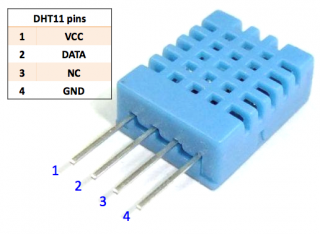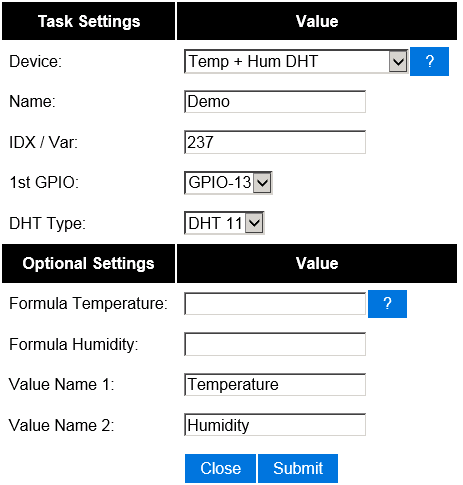Difference between revisions of "DHT11 DHT22"
Jump to navigation
Jump to search
| Line 23: | Line 23: | ||
Enter the IDX found in the Domoticz device page. Also select the GPIO pin that you have used to connect the DHT sensor. Finally you should select the type (DHT11 of DHT22). That should be all. | Enter the IDX found in the Domoticz device page. Also select the GPIO pin that you have used to connect the DHT sensor. Finally you should select the type (DHT11 of DHT22). That should be all. | ||
| + | |||
| + | === Optional settings === | ||
| + | |||
| + | [[ EasyFormula | Use of formulas]] | ||
| + | |||
| + | [[ EasyValueNames | Use of value names]] | ||
== ESP Connexio == | == ESP Connexio == | ||
Syntax: DHTRead "type", "pin", "var" | Syntax: DHTRead "type", "pin", "var" | ||
Revision as of 08:21, 3 October 2015
Contents
Introductie
The ESP module can read a DHT11 or DHT22 temperature/Humidity sensor using a custom onewire protocol.
The DHT sensor needs to be connected to a configurable GPIO on the ESP module. In case you have a simple ESP-01 module, it's best to use the GPIO-2 pin.
Hardware
The DHT sensor can be connected directly to an ESP module.
Software
Custom Sketch
ESP Easy
Use the device tab on the ESP Easy webinterface and create a new task by editing one of the available tasks. Select "DHT Humidity Sensor" from the dropdown box.
Enter the IDX found in the Domoticz device page. Also select the GPIO pin that you have used to connect the DHT sensor. Finally you should select the type (DHT11 of DHT22). That should be all.
Optional settings
ESP Connexio
Syntax: DHTRead "type", "pin", "var"


